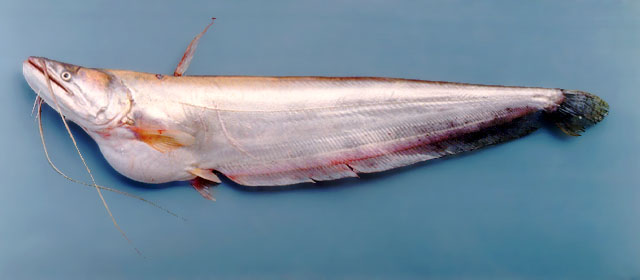| Siluridae (Sheatfishes) |
| 240 cm TL (male/unsexed) |
|
demersal; freshwater; brackish, potamodromous |
| Asia: Pakistan to Viet Nam and Indonesia. Reported from Afghanistan (Ref. 39701). Lower risk - near threatened status in Western Ghats, India (Ref. 44149). |
|
Dorsal soft rays (total): 5-5; Anal soft rays: 77-97. Head broad, snout depressed. Body elongate, strongly compressed. Mouth very deeply cleft, its corner reaching far behind eyes. Teeth in jaws set in wide bands; vomerine teeth in two small patches. Barbels two pairs; maxillary barbels extending to anterior margin posterior of anal fin, mandibulary barbels to angle of mouth. Eyes small, with a free orbital margin. Dorsal fin small, anal fin very long (Ref. 4792). Mandibular barbel longer than pelvic fin; 24-30 gill rakers on the first arch (Ref. 12693). Eye in front of vertical through corner of mouth (Ref. 43281). |
| Found in large rivers, lakes and tanks. A large, voracious and predatory catfish which thrives in heels with grassy margin (Ref. 6028); mostly hides under holes in river banks and canals (Ref. 44149). Associated with deep, still or slow-flowing water with a mud or silt substrate (Ref. 6028). Sluggish and stays on muddy or silty bottom in search of food. Juveniles feed mainly on insects; adults feed on smaller fish, crustaceans, and mollusks. Oviparous, distinct pairing possibly like other members of the same family (Ref. 205). Abundant during the warm season; a pre-monsoon summer breeder. In the Mekong, it is reported to migrate to smaller streams, canals and to the floodplain during the flood season (Ref. 37770). When the water level in the Mekong drops and the flood recedes, it moves to the Mekong or larger tributaries, where it stays in deep pools until the next inundation period (Ref. 37770). Destructive to other more valuable food-fishes. Bites strongly if handled, with its huge mouth, formidable jaws, and band of conical teeth. Threatened due to over harvesting (Ref. 58490). |
|
Vulnerable (VU); Date assessed: 12 August 2019 (A2d) Ref. (130435)
|
| traumatogenic |
Source and more info: www.fishbase.org. For personal, classroom, and other internal use only. Not for publication.

